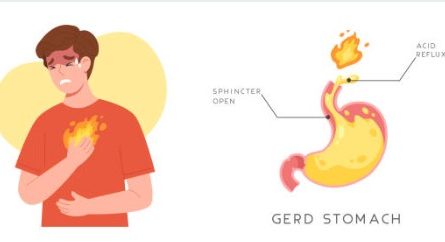Gastroesophageal reflux disease (GERD) is a chronic condition, and while it may not have a permanent cure, it can be effectively managed with appropriate treatment and lifestyle modifications. Here are some strategies that can help manage GERD symptoms.
Lifestyle modifications:
Maintain a healthy weight
Excess weight can put pressure on the abdomen and worsen GERD symptoms. Aim for a healthy weight through a balanced diet and regular exercise.
Avoid trigger foods and drinks
Identify and avoid foods and beverages that trigger your GERD symptoms. Common triggers include fatty and spicy foods, citrus fruits, tomatoes, chocolate, caffeine, and alcohol.
Eat smaller, more frequent meals
Consuming smaller portions and spacing your meals throughout the day can help prevent excessive stomach distension and reduce the likelihood of acid reflux.
Avoid lying down or going to bed immediately after a meal
Allow at least 2 to 3 hours for digestion before lying down to prevent stomach acid from flowing back into the esophagus.
Elevate the head of your bed
Raising the head of your bed by 6 to 8 inches (about 15 to 20 centimeters) can help prevent nighttime acid reflux.
Medications:
Over-the-counter antacids
Antacids provide temporary relief by neutralizing stomach acid. They can be taken as needed to alleviate symptoms.
H2 blockers (Histamine-2 receptor antagonists)
These medications reduce stomach acid production and can provide longer-lasting relief. Examples include ranitidine (Zantac) and famotidine (Pepcid).
Proton pump inhibitors (PPIs)
PPIs are prescription medications that effectively reduce stomach acid production. They are often used for more severe or chronic cases of GERD. Examples include omeprazole (Prilosec), esomeprazole (Nexium), and pantoprazole (Protonix).
Surgical interventions
In some cases, when lifestyle modifications and medications do not provide sufficient relief, surgical options may be considered. These procedures aim to strengthen the lower esophageal sphincter or create a barrier to prevent acid reflux. Examples include fundoplication and LINX device implantation.
It’s important to consult with a healthcare professional for an accurate diagnosis and individualized treatment plan. They can assess the severity of your GERD, consider any underlying conditions, and recommend the most appropriate treatment options for you. Keep in mind that the goal of treatment is to manage symptoms and improve quality of life rather than achieving a permanent cure for GERD.
What surgery is needed for GERD
In cases where lifestyle modifications and medications are not sufficient to manage GERD symptoms, surgical interventions may be considered. The specific type of surgery recommended can depend on various factors, including the severity of symptoms, response to conservative treatments, and individual patient characteristics. Here are two common surgical options for GERD.
Fundoplication
Fundoplication is a surgical procedure that aims to strengthen the lower esophageal sphincter (LES) and prevent acid reflux. During the procedure, the upper part of the stomach is wrapped around the lower esophagus, creating a tighter valve and improving its ability to prevent stomach acid from flowing back up. Fundoplication can be performed as open surgery or minimally invasive laparoscopic surgery.
LINX device implantation
The LINX procedure involves the implantation of a small, flexible ring of magnetic beads around the LES. The magnetic beads help keep the LES closed to prevent acid reflux while allowing food to pass through. This procedure is typically performed using minimally invasive techniques.
Both fundoplication and LINX device implantation aim to provide long-term relief from GERD symptoms and reduce the need for medication. They are usually considered for individuals with severe or chronic GERD who are not adequately managed with other treatments. It’s important to note that these surgical interventions are not appropriate for everyone, and the decision to undergo surgery should be made in consultation with a healthcare professional after a thorough evaluation.
Surgery for GERD carries risks and potential complications, so it’s important to have a comprehensive discussion with a healthcare professional who can evaluate your condition, explain the potential benefits and risks of each surgical option, and help determine the most suitable course of treatment for your specific situation.
How much is Surgery for GERD in United States?
The cost of GERD surgery in the United States can vary widely depending on several factors, including the type of surgery, the location of the procedure, the surgeon’s experience, the specific healthcare facility, and the patient’s insurance coverage. It is essential to note that the following figures are rough estimates and can differ significantly:
Fundoplication surgery – The cost of fundoplication surgery can range from $10,000 to $25,000 or more, depending on the factors mentioned above.
LINX device implantation – The cost of LINX device implantation can be around $12,000 to $20,000 or higher, depending on the factors mentioned above.
These estimated costs typically include the surgeon’s fees, anesthesia fees, hospital or surgical facility charges, pre-operative testing, and post-operative care. It’s important to remember that these costs are approximate and can vary significantly. Additionally, insurance coverage and individual financial arrangements can influence the out-of-pocket expenses for the patient.
To obtain an accurate estimate of the cost of GERD surgery, it is recommended to consult with your healthcare provider and contact your insurance company to understand your coverage and potential financial responsibilities. They can provide more specific information based on your individual circumstances and help you navigate the financial aspects of the procedure.









